A lot has changed in the performance cylinder head market since my last head story in EB in 2010. First of all, 600hp is the new 500hp, and if a power adder is involved, you’d better be packing 800hp to have any bragging rights at all. Heck, you can now buy production cars like the Dodge Hellcat that make over 700hp and tuner shops are setting up Mustangs and Camaros with 800hp-1,000hp at the rear wheels on a daily basis.
More enthusiasts are using their streetcars at track day events and autocross, so factors such as weight distribution have become a major consideration in component selection. Plus, the new hoards of car builders spawned by reality shows like Gas Monkey Garage seem to have two-year waiting lists, but most are installing factory crate motors – not a trend engine builders want to see.
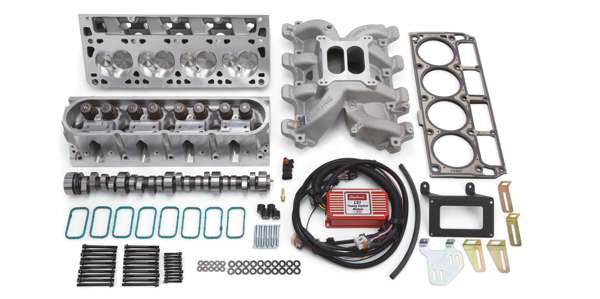
What this means for the PERFORMANCE cylinder head market is that rebuilt and ported factory cast iron O.E. heads are in the rearview mirror. Aftermarket aluminum heads can remove up to 100-pounds off the front end of a car moving it closer to the goal of 50/50 optimum weight distribution. Plus, most have port and valve sizes designed to support 600hp-plus. Also, they are available in a variety of port and chamber sizes to fit a variety of engines and applications – it’s no longer a one-size fits all proposition.
And I’ve saved the best news for last: The entry-level, street performance alloy head market has become extremely cost effective. You cannot correctly rebuild a set of iron heads (hard seats, new guides, seals, springs and exhaust valves – plus labor) for significantly less than you can buy an all-new set of complete aluminum heads. Sure, there’s still a large demand for aftermarket cast iron cylinder heads and they may be attractive options from a cost and power output perspective, but for someone looking for the weight savings and the ultimate performance potential of today’s cylinder heads, there really is no substitute for aluminum.
The Imported Head Effect
What’s driving and keeping the cost down on aftermarket heads in general is the influx of imported cylinder heads (and I don’t mean imported from Germany). Opinions vary whether these heads are a good or a bad thing for the industry, but they have had the effect of keeping all entry-level prices down for both domestic and imported heads. A great example are the Flo-Tek 180cc intake runner SBC aluminum heads that sell complete with stainless steel valves at major retailers for $398 each. Junk heads? Hardly. In numerous enthusiast magazine cylinder head shootouts Flo-Teks consistently finish at or near the top of the charts.
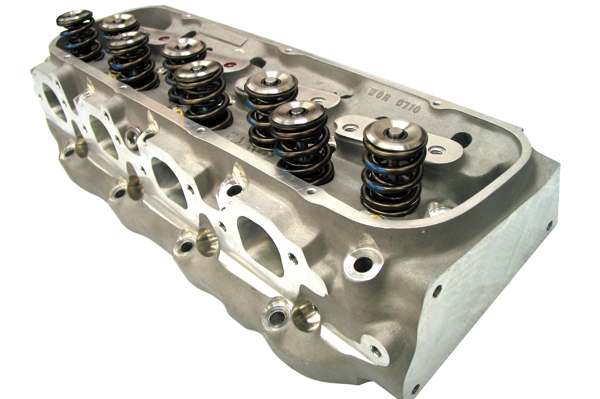
Flo-Tek owner Ron Schmitt traces the lineage of his heads to when he was a dealer for the New Zealand-based Pro-Action cylinder heads. When Pro-Action went out of business, Schmitt had local race shop, Jones Engineering revise a set of SBC and SBF Pro-Action castings which he took to China and found an O.E. parts manufacturer to make the essentially new Flo-Tek castings. Ron sourced the other components and carefully assembles Flo-Tek Performance heads at his Tri-State Cylinder Head shop in Evansville, IN that specializes in diesel head repair. So unlike that unknown head you just bought on eBay, Ron can service any warranty problems that may arise at his Tri-State Cylinder Head facility.
Domestic Heads Meet the Price Challenge
Is there a domestic counterpart to Flo-Tek? Iconic parts maker Edelbrock has an entry-level line of aluminum heads called its E-Street series that sells for $922/pair – a perfect alternative to rebuilt iron heads. If you are looking for more performance, Edelbrock offers Performer, Performer RPM, E-CNC, E-Series, Victor Jr. and Victor models – power and price for every budget.
Edelbrock is not the lone domestic head maker in the fight. Well-known race head maker Brodix has introduced a new series (IK) of 23-degree SBC heads that retail for approximately $995. The name of Brodix’s “IK” series is a self-contained mission statement – Iron Killer. They are available in 180cc, 200cc and 210cc intake runner versions and are directed at those consumers looking for the most bang for their buck.
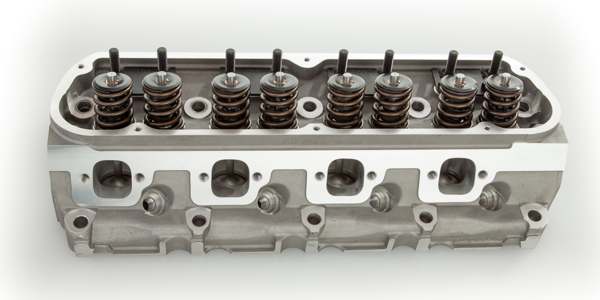
Step up slightly in price and there are a bunch of proven performers like Dart’s SHP 23-Degree head for $1,180, TFS’s Super 23 at $1,598 and AFR’s fully CNC-ported SBC Eliminators for $1,647.
Even large engine builders like production engine remanufacturer ATK have jumped into the crowded SBC alloy head market with its own version. ATK’s Brandon Simkiss said that they were not impressed with the heads they were getting for their in-house high-performance crate engine program, so they joined up with race head designer and manufacturer, Profiler, to design a proprietary head for ATK (Profiler sells a version of this head that is different from the ATK head). They offer three 23-degree SBC castings with 185cc, 195cc and 210cc port volumes, available with 64cc or 70cc combustion chambers. They retail starting at $1,150. Future plans call for a series of small-block Ford castings.
The Price vs. Power Relationship
While price is a big driver for what sells in the aftermarket cylinder head arena, it shouldn’t be our only consideration (and, just a reminder, the prices I quote here are retail prices. Talk with your performance WD about your professional cost). One of the reasons car builders are trending to factory crate motors is that they deliver guaranteed extreme power levels, driveability and reliability. Unfortunately, or fortunately (depending on your point of view) these ultra-performance crate engines carry a steep price. A sharp engine builder can easily offer the end user and car builder much more “bang for their buck” with some carefully selected pieces, and the “correct” cylinder head for the application is the cornerstone of the engine combination.
There is a key relationship between port flow, camshaft timing and engine displacement. The only way to optimize this relationship is through days of flow bench and dyno testing. With that being out of reach for most of us, it is a good idea to rely on manufacturers’ recommendations. Edelbrock was probably the first with its Top-End Kits and Total Power Packages. Trick Flow Specialties (TFS) has since offered head/cam packages and Dart, Brodix, Indy Cylinder Head and others offer top-end kits with coordinated heads and manifold packages.
Introducing the ‘4th’ Power Adder
While it is widely accepted that there are just three “power adders” – superchargers, turbos and nitrous – I submit to you that there is a “fourth” power adder and it is an aftermarket cylinder head, and more accurately a cylinder head “top-end kit.” Many of these new CNC-ported optimized cylinder heads can add up to 100hp or more, and “top-end kits” can bump that figure to 200hp-plus. Some good examples are TFS’s kits for the 225hp 5.0L Ford that have produced 432hp; its 4.6L 2V kits take the 260hp motors to 380hp and both TFS and Edelbrock have a kit that will take the 300hp-340hp 6.0L LS to 550hp. Each company has its own list of components for these top-end kits and they vary greatly in price, but they are worth checking out.
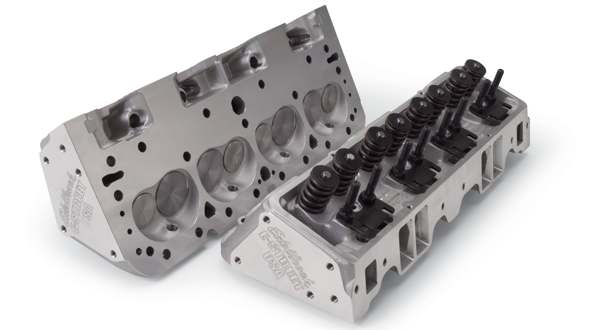
So how do these top-end kits stack up against traditional power adders? Most superchargers running on pump gas do well to deliver 125hp on an average 350ci engine – the same goes for turbos without extensive intercoolers. And anyone who has used nitrous oxide knows that the 125hp kits are safe and simple, but after that, you’d better know what you are doing. Trick Flow’s Artie Kakiou was quick to point out that these traditional power adders add weight and complexity to the engine compartment making the engine more difficult to work on.
A Head For Every Engine
A couple of other developments have been evolving since 2010 that are good for the market and great for car enthusiasts everywhere: There is now an aftermarket aluminum head available for virtually every popular V8 engine ever made, plus a new generation of hybrid heads (heads that cross-over engine families like LS1 and LS3). So, if you are building a Ford Y-Block, 500 cid Cadillac, 401 AMC, early Chrysler Hemi and even Ford Flathead, there’s probably a modern aluminum head available for it.
New Trends in Head Design
Besides this new generation of hybrid heads, cylinder head makers have thrown convention to the wind and have come up with radical redesigns like TFS’s 4.6L 2V that has moved the intake valve and combustion chamber to the opposite (of O.E.) side of the camshaft. A good example of a hybrid head is RHS’s LS7 Pro Elite head that is designed to fit smaller bore LSs (down to 3.900˝) replacing cathedral-style heads on 5.7L-6.0L blocks. It features an LS7 port style raised .220˝ that accepts LS7 manifolds. Brodix is offering its series of LS7-style heads with larger 1.650˝ spring pockets for those aggressive roller cams requiring more valvespring pressure. Dart and others offer race-style heads with shallower valve angles that unshroud the valves and aid in power production. Dart’s latest 9-degree SBC race casting is sold un-finished for head porters and engine builders to port to their needs. Most cylinder head makers are offering their castings in raw or semi-finished forms.
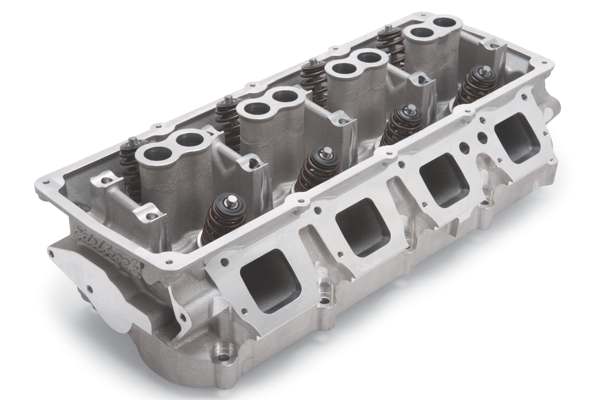
A few new cylinder heads set for release are a set of Gen III Hemi heads from Edelbrock that are a dual plug design and fit either style of Gen III Hemis. TFS is introducing its DHC (double-hump) castings for small-block Chevys that look like the original “fuelie heads” with the double-hump casting bumps, and they will also be available with optional bosses and bolt-holes to accept later accessories. TFS is also introducing a new Ford FE head and intake around August of this year.
A Few Words of Caution
Some things to watch out for when selecting cylinder heads for the newer style engines like the LS. First is bore size, make sure the head you are purchasing is intended for the bore size of your engine – example, most LS7 heads will not fit on the 4.8L-5.3L. GM LSX and many aftermarket race blocks have six head bolts as opposed to O.E. production’s four head bolts. Another item to watch out for is that many head makers are slightly raising port locations for big improvements in power. Make sure that these slight changes are not going to cause you or your customer installation issues further down the line.
The best advice is talk to a factory tech/rep about which of their cylinder heads is best for your application. Especially when they have confused the issue with multiple series of heads and model names that may, or may not, reflect the true application of the cylinder head.













